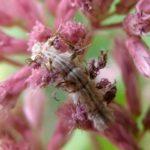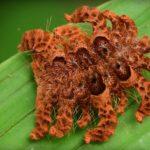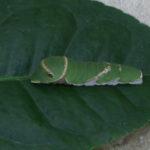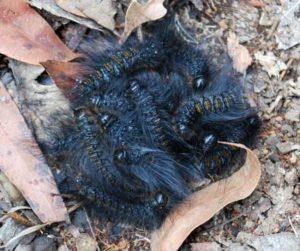Dangerous caterpillars: 8 beautiful and poisonous representatives
Caterpillars are an intermediate form in the life cycle of Lepidoptera insects. Just like butterflies, they differ from each other in appearance, behavior and lifestyle. These insects have a lot of natural enemies, and therefore most species shyly hide in the leaves of the host plant. But there are also individuals who feel much bolder and more confident than the rest, and these are poisonous caterpillars.
Content
Features of poisonous caterpillars
The main distinguishing feature of poisonous caterpillars is the presence of toxic substances in their body. The poison is found at the tips of the spines, spine-like processes, hairs or villi that cover the body of the insect.
The main external sign of the toxicity of the larva is the variegated color.
Many types of caterpillars blend into their environment like chameleons, but poisonous species are almost always bright and catchy.
What danger to humans are poisonous caterpillars
Most poisonous caterpillars can only cause redness and slight itching on the skin in humans. However, There are many species, in contact with toxic substances of which, there is a serious threat to health and even human life.
Contact with the most dangerous representatives of toxic caterpillars can lead to the following consequences:
- disorder of the digestive system;
- headache;
- rash;
- fever;
- pulmonary edema;
- internal hemorrhages;
- nervous system disorder.
The most dangerous types of poisonous caterpillars
The most dangerous species of poisonous caterpillars live in tropical and subtropical climates. The number of insects in this group is quite large, but some of them deserve special attention.
caterpillar coquette
The coquette caterpillar is one of the most dangerous insects. Outwardly, the caterpillar looks completely harmless. Her whole body is densely covered with long hairs. At first glance, it may seem that this is not a larva at all, but a tiny fluffy animal. The color of the hairs ranges from light gray to red-brown. The length of the insect is about 3 cm.
The natural habitat of the coquette caterpillar is North America. Contact with its hairs causes acute pain, redness on the skin and bruising in a person. After some time, there is shortness of breath, swollen lymph nodes and chest pain.
saddle caterpillar
The caterpillar is painted in a bright, light green color. At the ends, the body has a dark brown color and a pair of processes that look like horns. The horns of the caterpillar are surrounded by hard villi containing a potent poison. In the center of the back of the caterpillar there is an oval speck of brown color, with a white stroke. This spot has an external resemblance to a saddle, for which the insect got its name. The body length of the caterpillar does not exceed 2-3 cm.
The saddle caterpillar is found in South and North America. After contact with an insect, pain, swelling of the skin, nausea and a rash may occur. These symptoms may continue for 2-4 days.
Caterpillar "lazy clown"
The body of the insect reaches a length of 6-7 cm. The color of the caterpillar is mainly in greenish-brown tones. The entire body is covered with herringbone-shaped processes, at the ends of which dangerous poison accumulates.
Most often, the "lazy clown" is found in the countries of Uruguay and Mozambique. This species is considered the most dangerous to humans. Contact with caterpillars causes painful hemorrhages in humans, renal colic, pulmonary edema, and can lead to disorders of the nervous system and even death.
Caterpillar Saturnia Io
Caterpillars of this species at a young age have a bright red color, which eventually changes to bright green. The body of the caterpillar is covered with spiny processes containing a poisonous substance. Contact with insect venom causes pain, itching, blisters, toxic dermatitis, and skin cell death.
Caterpillar Redtail
The color of the insect can vary from light gray to dark brown. The body of the caterpillar is covered with many hairs, and in its back part there is a bright “tail” of reddish villi.
The insect is widespread in many countries of Europe and Asia. On the territory of Russia, it can be found almost everywhere, except for the Far North. After contact with the villi of the caterpillar, a rash appears on the skin, itching and an allergic reaction occur.
Caterpillar "burning rose"
The insect is colored bright green, with a pattern of black stripes and spots of yellow or red. The body length of the caterpillar reaches 2-2,5 cm. On the body of the insect there are processes covered with poisonous spikes. Touching these spikes can cause severe skin irritation.
Caterpillar of the she-bear
The body of the insect is covered with thin, long hairs and decorated with alternating stripes of black and yellow. The caterpillar accumulates toxic substances in itself by eating the poisonous plant "ragwort".
Insects of this species are widespread in many countries. In Australia, New Zealand and North America, they were even used to control the growth of the ragwort. For humans, contact with them is dangerous and can lead to urticaria, atopic bronchial asthma, kidney failure and cerebral hemorrhages.
Caterpillar "hiding in a bag"
These insects live in small groups in a bag house made of silk. The body of the caterpillar is densely covered with long black hairs, contact with which can be very dangerous.
The poisonous substance found at the ends of the villi is a potent anticoagulant. If it enters the human body, it can lead to severe internal or external bleeding.
Conclusion
There are a huge variety of caterpillars in the world and it will not be difficult to meet them in nature. Of course, most species living in temperate climates are safe for humans, but there are exceptions. Therefore, having met with beautiful and unusual caterpillars, the surest decision would be to admire them from afar and pass by.




